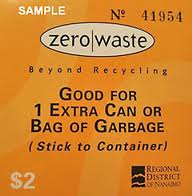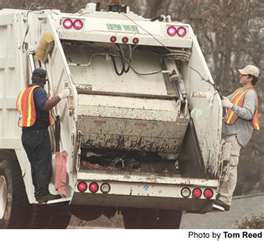BURLINGTON, ON November 16, 2011 The Region is responsible for garbage and waste collection and is going to introduce a tag day – and it isn’t what you might think it is. More of your tax dollars go to the Region than the city but that’s another story.
On Wednesday, November 16, Regional Council approved Halton’s new Solid Waste Management Strategy which will guide Regional waste management programs towards the goal of achieving a 65 per cent waste diversion rate by the year 2016.
While there are six to the strategy the one that is going to catch you eye is the requirement at some point in the future to put a tag on the fourth bag of garbage you put out. Fun, fun this one – so let’s cut to that chase right away.

The face of things to come - Region approves policy that includes tags for garbage bags that go over the limit.

Word is that you will be able to buy the things in shheets of ten. We suggest having school crossing guards seol the things as a side line..
This is going to be the tough one. No word on quite when this will get introduced, exactly how much the tags will cost or where you will go to buy the things. The municipalities are clearly going to have to be part of this – no one is going to drive to Bronte Road for a couple of $1. garbage bag tags.
So how will I get a tag? Might have to trot down to city hall – oops they close pretty early and they aren’t open on the weekends.
Maybe I can call my council member. He might have a stash in his desk drawer. Maybe they will attach a tag or two to their campaign literature – Dennison (my council member) will get my vote for that courtesy.
Retailers won’t want to have anything to do with them but school crossing guards could set up a side line by keeping a pocketful of garbage tags and marking them up by 25 per cent – worth the extra quarter for me – because you know the day you need one of the things – you won’t be able to find it in the kitchen drawer, and it will provide a little extra spending money for the crossing guard.
Can’t ask the neighbour if he has one to spare; haven’t returned the Skill saw he loaned you a month ago because you broke the thing.
One of the more than a dozen Communication specialists employed by the Region advised me that with the policy now approved the thinkers in the garbage collection department will put their minds to this one and come back with rules and regulations that will guide us all.
These things take time to get put together – the bureaucrats should though be able to have it figured out by – say the summer of 2014, which is when you get to re-elect the rascals that gather around the city council table. There you go – an election issue.
Back to the actual strategy:
Halton Region began a public engagement process this past spring asking residents for their feedback on eleven potential waste diversion initiatives included in the Region’s Draft Solid Waste Management Strategy. The process included four open houses and a phone and web survey to make it easy for residents to provide feedback and have their say on the proposed initiatives.
“The previous 2006 to 2010 Solid Waste Management Strategy guided Halton Region through significant curbside program changes including the introduction of the GreenCart and weekly Blue Box collection which has led to single family homes diverting 60 per cent of their waste. According to Ontario benchmarking, Halton has the highest waste diversion rate in the province,” said Gary Carr, Halton’s Regional Chair. “By approving this new Solid Waste Strategy, Regional Council is continuing to support Halton as a provincial waste diversion leader in order to work towards a new waste diversion goal of 65 per cent.”

They don`t want to take more than three bags of your garbage - more than that and you will need a tag - that you will have to purchase.
Resident feedback from the public engagement process supported achieving the new waste diversion goal of 65 per cent through the implementation of six key initiatives from the Draft Strategy. These initiatives have now been approved by Regional Council and will be put into place over the next five years.
1: Enhance promotion, education and outreach – increased promotion and education strategies include using social media, developing multi-media tools, developing a waste-less campaign and reaching diverse communities.
The Region believes that by educating citizens they will get a better buy in to the changes they need to make in the way they manage waste in Burlington, Oakville, Milton and the communities in Halton Hills
2. Enhance textile communications – expansion of existing textile diversion options for material such as clothing to capture more of this available material.
3. Enhance multi-residential waste diversion – enhancing Blue Bin recycling program and introducing GreenCart composting in multi-residential apartment buildings, engaging multi-residential community ambassadors and developing tenant/landlord recycling pledges.
4. Expand special waste drop-off events – introduce special waste drop-off days in areas not conveniently accessible to a current drop-off centre such as the Halton Waste Management Site.
5. Expand Blue Box materials and enhance Blue Box capacity – expand the list of eligible Blue Box materials to include additional items.
6. Decrease garbage bag limit and introduce bag tags – decrease the garbage limit to three bags/cans of garbage every other week. In order to place more than three bags/cans of garbage at the curb, residents would need to buy “bag tags” which typically cost $1 to $2 in other municipalities with similar programs.
It is important to note that 80 per cent of all houses currently place three bags or less of garbage at the curb.

















